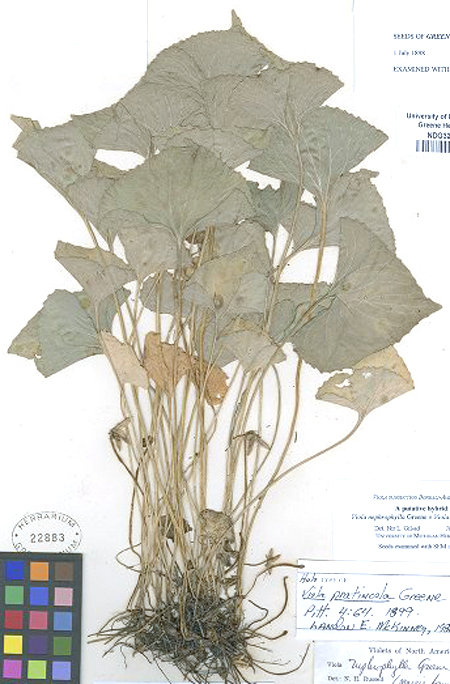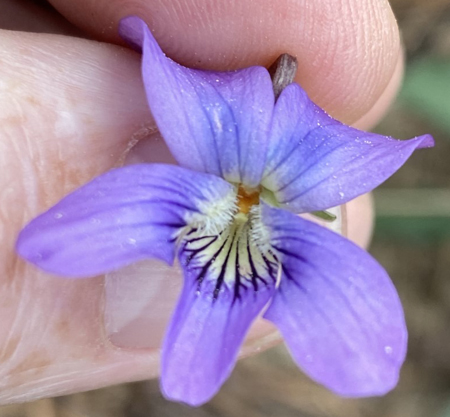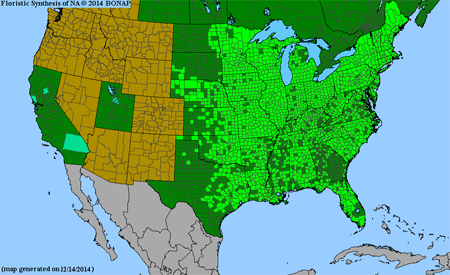Viola sororia [species complex]
Common names:
Common Wood Violet, Woolly Blue Violet
Synonyms:
See subordinate taxa.
Subordinate taxa belonging to this species:
Viola sororia Willd. [sensu stricto]
Viola sororia [glabrous variant]
Viola sororia [hirsutuloides variant]
Description:
Acaulescent rosulate perennials from thick commonly branching rhizome, ≤ 34 cm tall; foliage and peduncles green with leaves often turning yellow-green in fruit, sparsely to densely hirsute, and calyx ciliate in basal half (V. sororia sensu stricto), or foliage and peduncles green and glabrous and calyx eciliate (V. sororia [glabrous variant]), or foliage and peduncles darker blue-green with midrib, lower surface of leaf blades, petioles and calyx purple-tinged, foliage and peduncles strictly glabrous or with petioles occasionally sparsely hirtellous, and calyx eciliate (V. sororia [hirsutuloides variant]); stipules free, irregularly glandular-fimbriate; leaves ascending to spreading, leaf blades undivided, largest ≤ 121 × 126 mm, in flower ovate to reniform with base cordate and apex acute to broadly rounded, in fruit broadening to ovate-deltate or reniform-deltate, base deeply cordate to nearly truncate, apex abruptly acute or obtuse-angulate, and margins appressed-ciliate and prominently incurved-serrate with teeth lower and more remote near apex (V. sororia sensu stricto and V. sororia [glabrous variant]), or leaf blades broadly rounded at apex, margins eciliate and shallowly and closely crenate or crenulate-serrulate (V. sororia [hirsutuloides variant]); chasmogamous peduncle held among the leaves (sometimes above the leaves earlier in flower, especially in lawns and other disturbed sites); chasmogamous flower ≤ 21 mm; calyx glabrous; lowest sepals narrowly oblong-ovate to ovate, or occasionally ovate-triangular with distal half subattenuate, obtuse to rounded; auricles short and entire, not elongating in fruit; corolla blue to purple, throat white; spur short-globose; lateral petals densely bearded with filiform to slightly clavate hairs, spurred petal glabrous; chasmogamous capsule green; cleistogamous flowers produced after chasmogamous, on prostrate peduncle much shorter than petioles and arching upward just before capsule dehiscence; cleistogamous capsule 6–11 mm, green drying tan with purple spots or blotches, glabrous; seeds 1.5–2.6 × 0.9–1.6 mm, light to dark gray or grayish-brown with weak brown streaks or blotches; 2n=54.
Similar species:
The glabrous or densely hirsute foliage and ovate to reniform leaf blades with shallowly to deeply cordate base in this species are traits shared with most homophyllous uncut-leaved Borealiamericanae violets, and this has consequently led to great confusion and synonymization of many taxa into a hugely heterogeneous Viola sororia sensu lato. With its sparsely to densely hirsute foliage and ciliate sepals, Viola sororia sensu stricto differs from Viola septentrionalis in the appressed-ciliate leaf blade margins, glabrous spurred petal, sepals glabrous on the lamina and short-ciliate only in the basal half, short rounded auricles, and seeds medium gray to gray-brown with small weak streaks or blotches; and from Viola hirsutula in sparsely to densely hirsute foliage with pubescence not confined to the upper surface of leaf blades, spreading to ascending uniformly green leaves, ciliate sepals, glabrous spurred petal, and gray to gray-brown seeds with small weak streaks or blotches. With glabrous foliage and eciliate sepals, Viola sororia [glabrous variant] and Viola sororia [hirsutuloides variant] differ from Viola hirsutula in spreading to ascending glabrous uniformly green leaves, glabrous spurred petal, and gray to gray-brown seeds with small weak streaks or blotches. The two variants can be separated in chasmogamous flower from Viola communis and Viola domestica by their oblong-ovate to ovate sepals with obtuse to rounded apex, and short rounded auricles, and further from Viola communis by their dull leaf surfaces; from Viola cucullata in flowers held among the leaves, oblong-ovate to ovate obtuse to rounded sepals, short rounded auricles, corolla blue to purple without a contrasting eyespot around the throat, and lateral petal beards with long filiform to slightly clavate hairs; from Viola nephrophylla by their glabrous spurred petal, and from Viola pratincola by their oblong-ovate to ovate obtuse to rounded sepals, short rounded auricles, and glabrous spurred petal. In cleistogamous fruit Viola sororia [glabrous variant] and Viola sororia [hirsutuloides variant] differ from Viola communis, Viola cucullata, Viola domestica, Viola langloisii, Viola nephrophylla and Viola pratincola in their densely spotted or blotched cleistogamous capsules on prostrate peduncles; and from Viola affinis, Viola latiuscula, Viola missouriensis, hirsutula in their oblong-ovate to ovate obtuse to rounded speals, short rounded auricles, and gray to gray-brown seeds with small weak streaks or blotches.
Ecology:
Moist loamy, clayey or silty loam soils in dry-mesic, mesic and wet-mesic forests, on slopes, coves, or terraces along streams and rivers, and along prairie-forest borders; also in lawns, meadows and roadsides.
Distribution:
Widely distributed in e. North America, s. ME and s. ON to se. SK, south to FL and TX.
Rarity:
None.
Phenology:
Chasmogamous flower February–May (September–October), chasmogamous fruit February–June, cleistogamous fruit June–October.
Affinities:
This species belongs to the Acaulescent Blue Violet lineage, sect. Nosphinium W.Becker, subsect. Boreali-Americanae (W.Becker) Gil-ad, in the Sororia species group.
Hybrids:
See subordinate taxa.
Comments:
Even after segregating several distinct species out of the Viola sororia species complex in the broadest sense, Viola sororia is still a small and somewhat heterogeneous assemblage of three incompletely understood taxa which share undivided ovate to reniform leaf blades, a glabrous spurred petal, obtuse to rounded sepals, short rounded auricles not elongating in fruit, and purple-spotted or -blotched cleistogamous capsules on short prostrate to arching peduncles. Widely distributed V. sororia sensu stricto typically has sparsely to densely hirsute foliage and peduncles, leaf blades ovate to reniform with apex often abruptly obtuse or acute and marginal serrations prominently incurved and more remote near apex, chasmogamous flowers held among the leaves, sepals ciliate in the basal half, seeds medium gray with prominent dark gray streaks or blotches, and foliage sometimes turning yellow-green in mid-summer. Populations commonly show some variability in foliage pubescence, and it is not uncommon to find individuals with nearly glabrous foliage; in fact, on any given plant, one or more leaves may be nearly glabrous while others may be densely hirsute or express localized pubescence. The other two taxa in the complex have glabrous foliage (except possibly for scattered minute appressed hairs on the upper leaf surface that require magnification) and eciliate sepals, foliage that does not usually turn yellow-green later, and (based on very limited sampling) different seed color patterns. Viola sororia [glabrous variant] is distributed at higher elevations in the Appalachian Mountains and adjacent uplands and eastern Piedmont, and is morphologically similar to V. sororia sensu stricto except for glabrous foliage and eciliate sepals, leaf blades with slightly more uniformly crenate-serrate margins, seeds pale gray to gray-brown with prominent indistinct darker streaks or blotches, and foliage that does not usually turn yellow-green in late cleistogamous fruit. V. sororia [hirsutuloides variant] has been found sporadically throughout the Appalachian Mountains and associated uplands, from New York to northern Georgia, and is more divergent from the two taxa above in its darker blue-green foliage and peduncles, the lower surface of leaf blades distinctly paler than the upper, with the midrib on the upper surface, lower surface of the leaf blades, petioles, peduncles and calyces purple-tinged, and leaf blades ovate or orbicular to reniform with apex broadly rounded, margins uniformly low-crenate, and chasmogamous flowers often held above the leaves. These three taxa occupy mesic forests and terraces bordering floodplains and swamps, but they may be ecologically separated somehow. These taxa requre further study to determine their morphological distinctions, geographic distributions, ecology and taxonomic status. The entire complex is mapped together, due to our very fragmentary understanding of distributions for the three taxa. For information on other species that have historically been included within the broader Viola sororia assemblage, see comments under Viola communis, Viola domestica, Viola pratincola and Viola septentrionalis.
Literature Cited:
None.

Chasmogamous flowering habit of Viola sororia sensu stricto by Andrew Gibson, "Buckeye Botanist" website

Chasmogamous flowering habit of Viola sororia [glabrous variant] (plant in NC, Durham) by Alan Weakley

Chasmogamous flower front view of Viola sororia sensu stricto by Andrew Gibson

Chasmogamous flower front view of Viola sororia [glabrous variant] (plant in NC, Durham) by Alan Weakley

Seeds of Viola sororia sensu stricto from herbarium specimen: VT, Middlebury, moist thicket near mountain, 31 Jul 1903, E. Brainerd 159 (NY)

Seeds of Viola sororia [glabrous variant] from a herbarium specimen: Transplanted from PA, Delaware Co., Kelly Drive, H. Ballard 15-025Z (BHO)

Map of the Viola sororia species complex by the Biota of North America Program